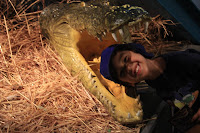 Arriving mid-morning at Edith Falls (Leilyn), we immediately don our cozzies and head for the famed swimming hole. Ahhh, what joy! Very cool waters to soothe the hot tribe – and what’s more, easier access into the water than at Florence Falls (Litchfield NP) which makes things more enjoyable for the tribe. The tribe take turns with the swimming rings and gain confidence in venturing in for a paddle.
Arriving mid-morning at Edith Falls (Leilyn), we immediately don our cozzies and head for the famed swimming hole. Ahhh, what joy! Very cool waters to soothe the hot tribe – and what’s more, easier access into the water than at Florence Falls (Litchfield NP) which makes things more enjoyable for the tribe. The tribe take turns with the swimming rings and gain confidence in venturing in for a paddle.Such a beautiful setting, we have a picnic lunch near the water and decide to stay the night in the adjacent camp grounds. This time, despite being a NP, we are allocated a site with an unfortunate lack of shade unlike our previous experiences at other NPs. We do however make use of any shade nearby to escape the searing sun. It appears that most sites at the park lack any decent shade.


Afternoon already, so another swim – so refreshing! I ponder the walk to the Upper Pool but decide to venture at sunrise when it is a lot cooler. One of the park rangers provides a show and tell in the evening which was hugely informative – explaining the changing ecology of the park due to differing grass types affecting insect-life and thus bird and reptile life. Also, the impact of cane toads and their devastation of native animals who don’t know better: within the first year, the numbers of freshwater crocs, water monitors and frilled-neck lizards are decimated until they learn that cane toads are a lousy food item to have on the menu.
 Also interesting is apparently, most snakes can swim and those in the park are generally on the ‘harmless’ scale – M mentioned that she thought a snake passed her when she swam in the pool.
Also interesting is apparently, most snakes can swim and those in the park are generally on the ‘harmless’ scale – M mentioned that she thought a snake passed her when she swam in the pool.An explanation as to the park’s name – Nitmiluk (which also covers Katherine Gorge) is that nitmi is the local name for ‘cicada’, and luk is ‘place of’. However, being winter, the cicadas are very quiet – thankfully.
The sunrise walk to the Upper Pool was a great way to start the day – the cool air before the sun peaked over the distant ridges made the ascent comfortable. There were a great range of native flora, and most peculiar is the kapok or crocodile flower – where local aboriginals observe when the plant shows fruit it coincides with the egg-laying of the crocodiles, and when the fruit ripens and bursts, then the eggs have hatched.
At the Upper Pool, I am greeted by solitary egret, taking slow measured steps seeking food in the waters. On my return crossing the creek that runs from the swimming hole at the falls, the forest was deafening with birdlife – mostly unseen apart from the quick crimson finch.
 On the display board along the footpath leading to the swimming hole, there is vast information on the animals and vegetation to the area. Dependent on time of year, this is the home to a variety of snakes and pythons, water monitors, birds and of course fish. We spot one of the grunters, archer (or rifle) fish, and catfish who all swim near us. Also, on the sign is a request (or warning) to not swim in at night as it is the time when crocs feed.
On the display board along the footpath leading to the swimming hole, there is vast information on the animals and vegetation to the area. Dependent on time of year, this is the home to a variety of snakes and pythons, water monitors, birds and of course fish. We spot one of the grunters, archer (or rifle) fish, and catfish who all swim near us. Also, on the sign is a request (or warning) to not swim in at night as it is the time when crocs feed.Glad to know they don’t take leisurely dip in the middle of the day to cool themselves.


















































